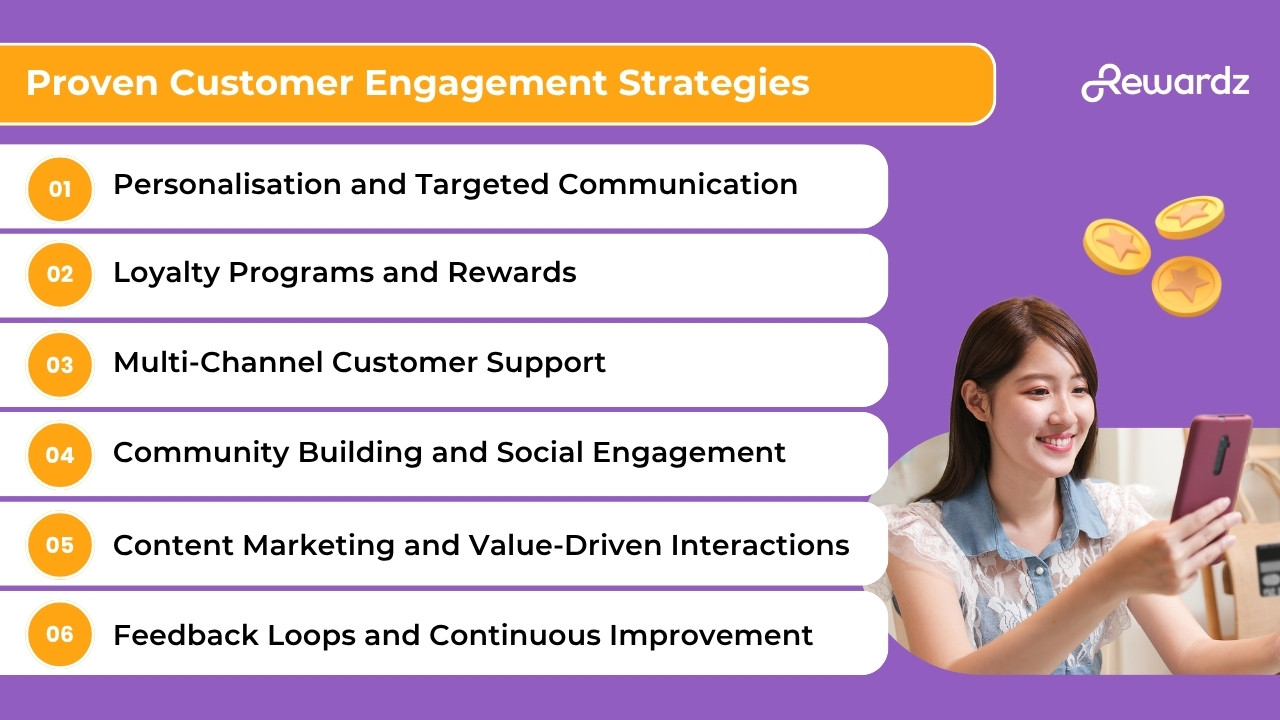Most businesses focus intensely on customer acquisition, pouring resources into attracting new prospects while their existing customers quietly slip away. This backwards approach ignores a fundamental truth: retaining and engaging current customers is far more profitable than constantly replacing lost ones. Customer engagement has evolved from a nice-to-have marketing concept into a critical business imperative that can make or break your company’s success.
According to a recent study by PwC, most customers will walk away from a brand they love after just one bad experience. That means brands need more than transactions, they need meaningful, ongoing relationships. Businesses that master the art of authentic customer relationships gain a significant competitive edge that translates directly to revenue growth and market position.
This guide will walk you through everything you need to know about customer engagement, from understanding its core principles to implementing effective strategies and choosing the right platforms to support your efforts.
Understanding Customer Engagement
Customer engagement refers to the ongoing emotional connection and interaction between a customer and a brand throughout their entire relationship journey. It encompasses every touchpoint, from the first awareness of your brand to post-purchase support and beyond.
At its core, customer engagement involves three key components:
Emotional Connection: This goes beyond mere transactions to create genuine feelings of trust, loyalty, and affinity toward your brand. Emotionally engaged customers don’t just buy your products, they become advocates who actively promote your brand to others.
Interaction Frequency: Regular, meaningful interactions keep your brand top-of-mind and strengthen the relationship over time. This includes both initiated interactions (like customer support requests) and brand-initiated touchpoints (such as personalised emails or social media engagement).
Brand Loyalty: True engagement manifests as customer loyalty that withstands competitive pressures, price fluctuations, and occasional service hiccups. Engaged customers are more likely to forgive mistakes and remain committed to your brand.
Customer engagement differs significantly from customer satisfaction and customer experience, though they’re related concepts. Customer satisfaction measures how well your product or service meets expectations at a specific moment, while customer experience encompasses the entire journey across all touchpoints. Customer engagement, however, represents the deeper emotional and behavioral commitment that develops over time through consistent positive interactions and value delivery.
The Business Impact: Why Customer Engagement Matters
Investing in customer engagement isn’t just about creating warm feelings, it delivers measurable business results that directly impact your bottom line. Here’s why customer engagement matters.
Increased Customer Lifetime Value: Engaged customers spend more money over longer periods. They’re more likely to make repeat purchases, upgrade to premium offerings, and explore additional products or services within your portfolio. Study shows that highly engaged customers can generate 23% more revenue than average customers.
Higher Retention Rates and Reduced Churn: It costs five to seven times more to acquire a new customer than to retain an existing one. Engaged customers are significantly less likely to switch to competitors, even when faced with lower prices or aggressive marketing from rival brands. This stability provides predictable revenue streams and reduces the constant pressure to replace churning customers.
Improved Brand Advocacy and Word-of-Mouth Marketing: Engaged customers become your most powerful marketing channel. They actively recommend your brand to friends, family, and colleagues, write positive reviews, and share their experiences on social media. This organic promotion is more trusted and cost-effective than traditional advertising.
Enhanced Revenue Growth and Profitability: Beyond direct purchases, engaged customers contribute to profitability through reduced service costs (they’re more patient and understanding), decreased marketing expenses (they’re easier to retain), and premium pricing acceptance (they’re less price-sensitive).
Competitive Advantage in Crowded Markets: In industries where products and services are increasingly commoditised, customer engagement becomes a key differentiator. Strong engagement creates switching costs and emotional barriers that protect your market share even when competitors offer similar or technically superior products.

Proven Customer Engagement Strategies
Effective customer engagement requires a multi-faceted approach that touches every aspect of the customer journey. Here are the most impactful strategies successful businesses use to build lasting relationships with their customers.
Personalisation and Targeted Communication
Today’s customers expect experiences tailored to their specific needs, preferences, and behaviors. In fact, Epsilon researched that 80% of consumers are more likely to buy from brands that offer personalised experiences. Use customer data to segment your audience and deliver personalised content, product recommendations, and communications.
This might include strategies as follows:
- Personalised email campaigns based on purchase history
- Customised website experiences that showcase relevant products
- Targeted social media content that speaks to specific customer segments.
Loyalty Programs and Rewards
Implement programs that recognise and reward customer loyalty. This could include points-based systems, tiered benefits, exclusive access to new products, or special discounts for long-term customers. The key is to make customers feel valued and appreciated for their continued business while encouraging deeper engagement with your brand.
One powerful example of this in action comes from a leading insurer in Singapore that transformed its approach to customer engagement using Rewardz’s SPUR solution. Previously relying on manual, resource-heavy processes to distribute rewards, the company faced growing challenges ranging from limited personalisation to rising expectations for instant, meaningful recognition.
By adopting SPUR, they were able to digitise and scale their reward programme significantly. With access to a rich, localised marketplace and real-time tracking tools, the organisation not only streamlined operations but also created a more rewarding experience for customers. The results speak for themselves:
- SGD 9.9M+ in rewards redeemed, reflecting high platform trust and engagement
- 125+ active users, showing strong uptake of a targeted reward strategy
- 89% usage rate, indicating sustained interest and satisfaction over time
This case highlights how investing in the right reward platform doesn’t just streamline operations, it elevates your entire engagement strategy.
Also read: 25 Impactful Loyalty Program Examples You Can Learn From
Multi-Channel Customer Support
Meet customers where they are by offering support across multiple channels—phone, email, live chat, social media, and self-service options. Ensure consistency across all channels so customers receive the same high-quality experience regardless of how they choose to interact with your brand. Implement seamless channel switching, allowing customers to start a conversation on one platform and continue it on another without losing context.
Community Building and Social Engagement
Create spaces where customers can connect with your brand and each other. This might include online forums, social media groups, user conferences, or local meetups. Foster discussions, share valuable content, and actively participate in conversations. Communities not only strengthen customer relationships but also provide valuable feedback and insights into customer needs and preferences.
Content Marketing and Value-Driven Interactions
Consistently provide valuable, relevant content that helps customers solve problems, learn new skills, or achieve their goals. This positions your brand as a trusted advisor rather than just a vendor. Develop educational blog posts, how-to videos, webinars, podcasts, or industry reports that demonstrate your expertise and commitment to customer success.
Feedback Loops and Continuous Improvement
Actively seek customer feedback through surveys, reviews, social media monitoring, and direct conversations. More importantly, act on this feedback by making visible improvements to your products, services, or processes. Close the loop by communicating back to customers about how their input led to positive changes, showing that you value their opinions and are committed to continuous improvement.
Customer Engagement Platforms and Tools
Delivering personalised experiences at scale requires the right technology. By understanding the key categories of customer engagement platforms, businesses can select tools that align with their goals and customer expectations.
Customer Relationship Management (CRM) Platforms
CRM systems centralise customer data, interactions, and history to give businesses a 360-degree view of each customer. This enables personalised communication and better tracking of customer journeys. Platforms like Salesforce, HubSpot CRM, and Microsoft Dynamics 365 are widely used for their robust features and scalability.
Loyalty and Rewards Platforms
These platforms help businesses build rewarding customer experiences by managing incentive programs that drive repeat engagement. Tools such as Rewardz, LoyaltyLion, and Antavo make it easy to gamify customer interactions and encourage ongoing brand loyalty.
Marketing Automation Platforms
Marketing automation tools streamline personalised messaging, segment audiences, and maintain customer relationships across the lifecycle. Solutions like Marketo, Mailchimp, and ActiveCampaign are effective for nurturing leads and delivering targeted content at the right time.
Social Media Management Platforms
To maintain consistent engagement across channels, businesses rely on social media tools that schedule posts, monitor conversations, and manage responses. Hootsuite, Sprout Social, and Buffer are among the most popular platforms for simplifying multi-network management.
Customer Support Platforms
Effective engagement extends to customer service. Platforms such as Zendesk, Intercom, and Freshworks support omnichannel communication, live chat, and ticketing systems to ensure responsive and seamless support experiences.
Best Practices for Customer Engagement Implementation
Sustained customer engagement requires a strategic, customer-centric approach built on clarity, consistency, and connection. Here’s our best practices for customer engagement implementation.
Building Your Foundation
Start with clear engagement goals and map the customer journey to identify key touchpoints. Audit current strategies, develop detailed personas, and maintain consistent content calendars. Set up communication guidelines and tracking systems to measure performance against baseline metrics.
Critical Mistakes to Avoid
Avoid overwhelming customers, quality and relevance matter more than frequency. Don’t treat all customers the same; personalisation drives stronger connections. Balance promotional messages with educational and entertaining content. Always respond promptly across all channels and address negative feedback transparently, it can build trust when handled well.
Long-Term Success Strategies
Think of engagement as a continuous process. Maintain consistency in messaging, but regularly test and refine your approach. Update personas as customer needs evolve and invest in team training to support effective execution. Stay aware of trends, but master the fundamentals before adding complexity
Ready to Engage Smarter?
Customer engagement has become the cornerstone of sustainable business growth, transforming how companies build relationships and drive long-term success. The strategies outlined in this guide—from personalisation and multi-channel support to loyalty programs and feedback loops—provide a comprehensive framework for creating meaningful customer connections.
Success in customer engagement requires the right combination of strategy, technology, and authentic commitment to customer value. Whether you’re implementing CRM systems, marketing automation, or loyalty platforms, the key is choosing solutions that align with your specific goals and customer needs.
If you’re looking to take your customer engagement to the next level, a unified solution like Rewardz can help you align incentives, automate engagement, and deliver unforgettable experiences. Reach out to explore Rewardz’ customer engagement solutions or subscribe to our newsletter for more insights.



